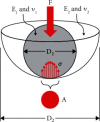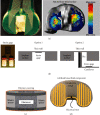Experimental Methods for Studying the Contact Mechanics of Joints
- PMID: 37780487
- PMCID: PMC10541306
- DOI: 10.1155/2023/4914082
Experimental Methods for Studying the Contact Mechanics of Joints
Abstract
Biomechanics researchers often experimentally measure static or fluctuating dynamic contact forces, areas, and stresses at the interface of natural and artificial joints, including the shoulders, elbows, hips, and knees. This information helps explain joint contact mechanics, as well as mechanisms that may contribute to disease, damage, and degradation. Currently, the most common in vitro experimental technique involves a thin pressure-sensitive film inserted into the joint space; but, the film's finite thickness disturbs the joint's ordinary articulation. Similarly, the most common in vivo experimental technique uses video recording of 3D limb motion combined with dynamic analysis of a 3D link-segment model to calculate joint contact force, but this does not provide joint contact area or stress distribution. Moreover, many researchers may be unaware of older or newer alternative techniques that may be more suitable for their particular research application. Thus, this article surveys over 50 years of English-language scientific literature in order to (a) describe the basic working principles, advantages, and disadvantages of each technique, (b) examine the trends among the studies and methods, and (c) make recommendations for future directions. This article will hopefully inform biomechanics investigators about various in vitro and in vivo experimental methods for studying the contact mechanics of joints.
Copyright © 2023 Radovan Zdero et al.
Conflict of interest statement
The authors declare that they have no conflicts of interest.
Figures




Similar articles
-
Empirical joint contact mechanics: A comprehensive review.Proc Inst Mech Eng H. 2023 Feb;237(2):147-162. doi: 10.1177/09544119221137397. Epub 2022 Dec 5. Proc Inst Mech Eng H. 2023. PMID: 36468563 Review.
-
Joint contact stress: a reasonable surrogate for biological processes?Iowa Orthop J. 2005;25:82-94. Iowa Orthop J. 2005. PMID: 16089079 Free PMC article. Review.
-
In vivo quantification of the cat patellofemoral joint contact stresses and areas.J Biomech. 1995 Aug;28(8):977-83. doi: 10.1016/0021-9290(94)00153-u. J Biomech. 1995. PMID: 7673264
-
Estimation of joint contact pressure in the index finger using a hybrid finite element musculoskeletal approach.Comput Methods Biomech Biomed Engin. 2020 Nov;23(15):1225-1235. doi: 10.1080/10255842.2020.1793965. Epub 2020 Jul 17. Comput Methods Biomech Biomed Engin. 2020. PMID: 32678683
-
The biomechanics of the human patella during passive knee flexion.J Biomech. 1995 Nov;28(11):1265-79. doi: 10.1016/0021-9290(95)00059-q. J Biomech. 1995. PMID: 8522541
Cited by
-
Navigating the Landscape of Dry Assembling Ordered Particle Structures: Can Solvents Become Obsolete?Small. 2024 Dec;20(49):e2405410. doi: 10.1002/smll.202405410. Epub 2024 Sep 16. Small. 2024. PMID: 39282807 Free PMC article. Review.
-
The Biomechanics of Musculoskeletal Tissues during Activities of Daily Living: Dynamic Assessment Using Quantitative Transmission-Mode Ultrasound Techniques.Healthcare (Basel). 2024 Jun 24;12(13):1254. doi: 10.3390/healthcare12131254. Healthcare (Basel). 2024. PMID: 38998789 Free PMC article. Review.
-
Quantitative gait analysis and prediction using artificial intelligence for patients with gait disorders.Sci Rep. 2023 Dec 28;13(1):23099. doi: 10.1038/s41598-023-49883-8. Sci Rep. 2023. PMID: 38155189 Free PMC article.
References
-
- Nordin M., Frankel V. H., editors. Basic Biomechanics of the Musculoskeletal System . 3rd. Philadelphia, PA, USA: Lippincott Williams and Wilkins; 2005.
-
- Garino J. P., Beredjiklian P. K., editors. Adult Reconstruction and Arthroplasty . Philadelphia, PA, USA: Mosby-Elsevier; 2007.
-
- Johnson K. L. Contact Mechanics . Cambridge, UK: Cambridge University Press; 1985.
-
- Popov V. L. Contact Mechanics and Friction . Berlin, Germany: Springer-Verlag; 2010. - DOI
-
- Lin D. C., Shreiber D. I., Dimitriadis E. K., Horkay F. Spherical indentation of soft matter beyond the Hertzian regime: numerical and experimental validation of hyperelastic models. Biomechanics and Modeling in Mechanobiology . 2009;8(5):345–358. doi: 10.1007/s10237-008-0139-9. - DOI - PMC - PubMed
Publication types
MeSH terms
LinkOut - more resources
Full Text Sources

